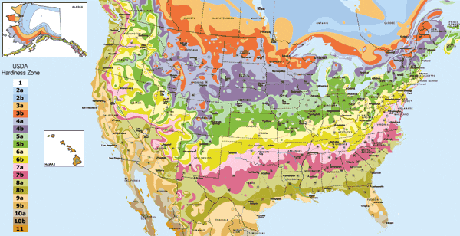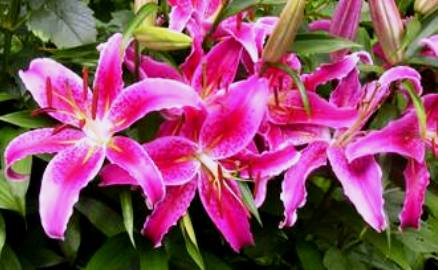The flowers of the liliumspecies generally grow on stately, sturdy stems and when grown in clusters shout out at you from the garden. Like tulips, lilies offer many color variations to choose from and are used extensively for cut flowers.Choose from down facing, up facing, and out facing flower heads and also large and bold trumpet-shaped flowers.
Lilies will grow in the same location for several years. The bulbs can be divided after a couple of years and be given away to neighbors or to grow more lilies.
When to plant:

Plant lily bulbs in fall after the ground has cooled, which means late September to early October in the northern states (zones 3-5), and into November in the southern states (zones 6-8). Click the map (right) to find your zone.They can also be planted in very early spring in warmer climates, but won’t flower as early and may have shorter flower stems the first year, according to the folks at The Lily Garden in Vancouver, Washington.
Where to plant:
Plant lilies in full sun or partial shade and in well drained, preferably sandy loam soil. Some species can be naturalized like tulips and daffodils, otherwise plant in clusters in a spring bulb garden or perennial garden. They also look impressive planted in front of a foundation near an entryway or in front of a picket fence
Planting depth:
Lilies come in a cluster of bulblets, much like garlic. Plant the entire bulb 6-10 inches deep, depending on the species. Plant lilies with their pointy end, or “eye” to the sky.
Spacing:
Space lilies about 6-8 inches apart.
How to plant lily bulbs:
Let’s face it, most bulb planting methods have us spending a lot of time bending over or on our knees. The ProPlugger 5-IN-1 Planting Tool allows you to do most of the hard work of digging your bulb planting holes from a standing position.
To pull plugs, slide the 2″ or 4″ metal depth ring onto the bottom of the main tube to set the desired depth of the planting hole. Or to dig a 6″ deep hole, no depth ring is needed.
(Step, Twist and Pour) Step down on the foot pegs until the depth ring bottoms out against the ground. Give the 5-IN-1 a slight twist to break the soil plug free and pull straight up on the handlebars. To empty the plugs, simply turn the plugger upside down and pour the plugs out of the top of the tube.
The soil gets stored inside the tool as you work, enabling you to dig over a dozen planting holes, one right after another. Place the bulb in the planting hole, pointed tip facing upward. Fill in the hole with the soil you removed with the 5-IN-1. Firm the soil over the bulb with your foot.
Fertilizing:
Feed with a 5-10-10 fertilizer when the leaf tips emerge. About the time of flowering, top dress with a 0-0-10 or 0-0-50 fertilizer. Fertilize in the spring of each year with a 5-10-10 fertilizer or all purpose fertilizer used for feeding flowers.
Disease and pest issues:
The Lily Beetle (Lilioceris lilii) is a fairly common pest and can strip the leaves, which is a problem, since it is the foliage that rejuvenates the bulb after flowering. Hand picking in the mornings can sometimes be enough to keep the problem in check. Otherwise, consider organic or natural pesticides, such as those containing pyrethrum.
Lily types:
There are different types of lilies to choose from, including the fragrant oriental lily, the stately Asiatic lily, the towering tiger lily, the conspicuous trumpet lily, and a new one on the market, Orienpet, a clever cross between an oriental lily and a trumpet lily. All of the above make great cut flowers.
Hardiness Zone:
Lilies are hardy in zones 3-8; however, this varies by variety, so always check to make sure the lilies you purchase are hardy for your area.
Neil Moran is a horticulturist and author of three books on gardening. He is also the creator and author of the garden blog North Country Gardener
Additional Resources:
Be sure to check out the helpful information on our website, including other uses for the ProPlugger including:

